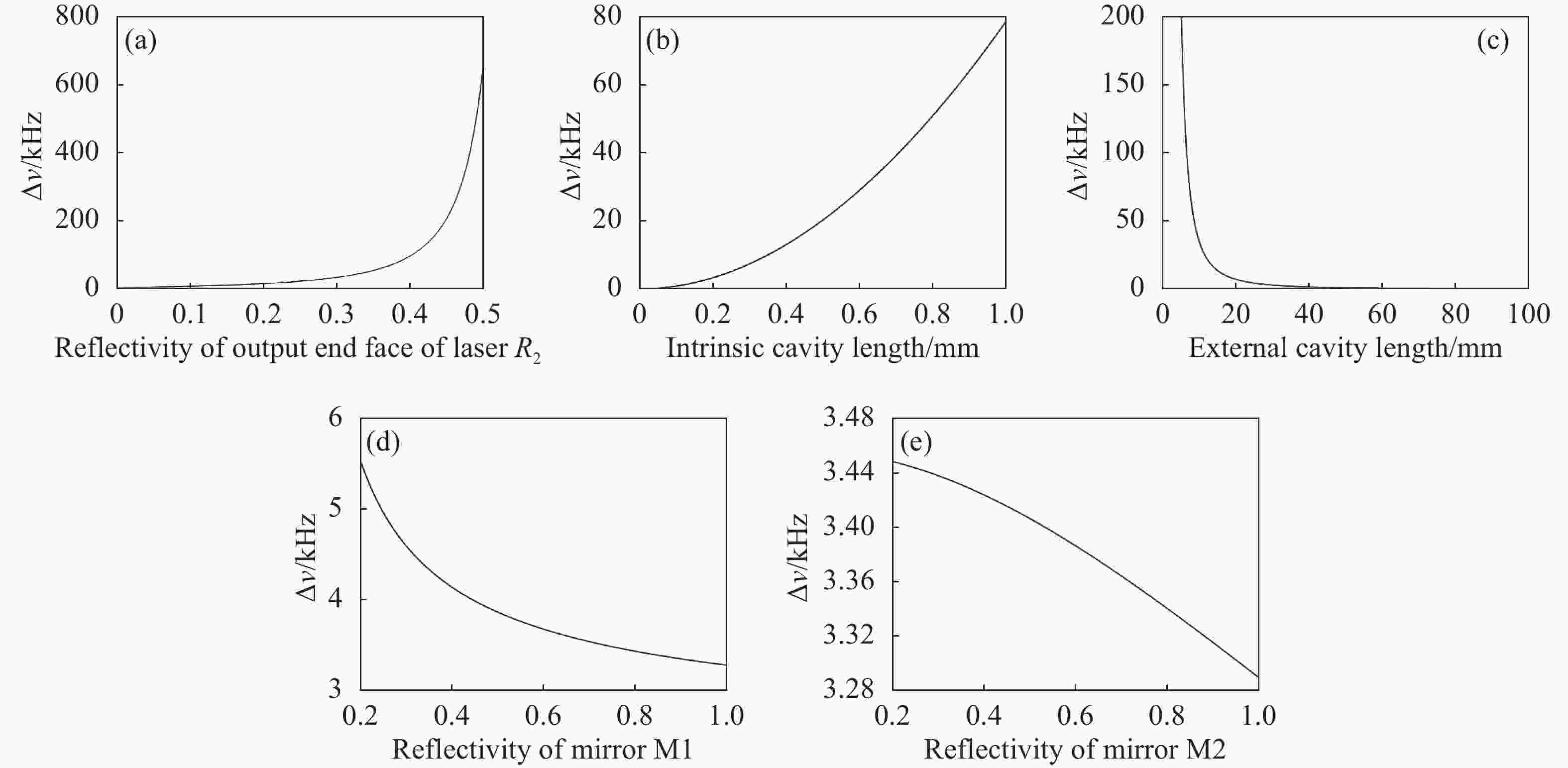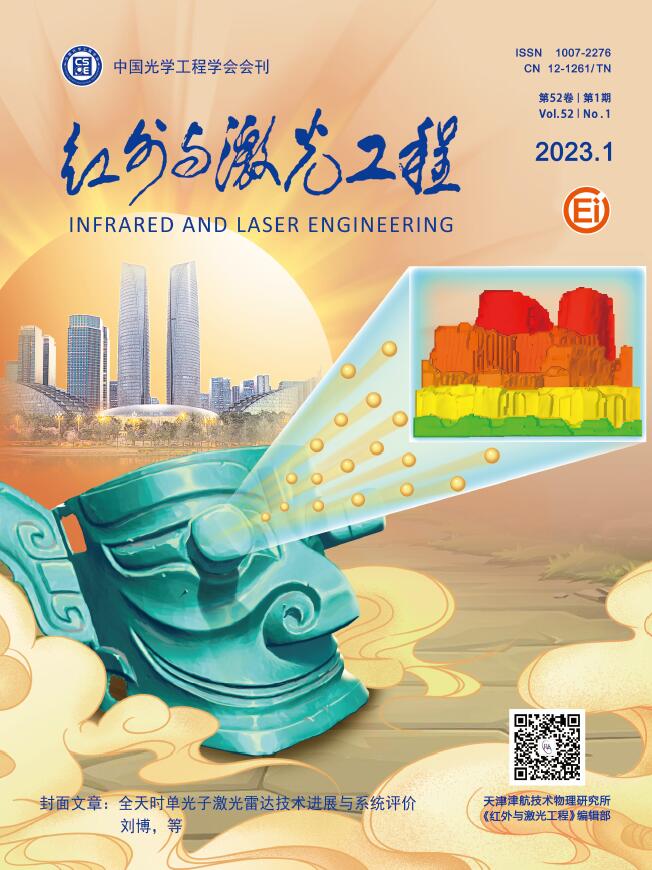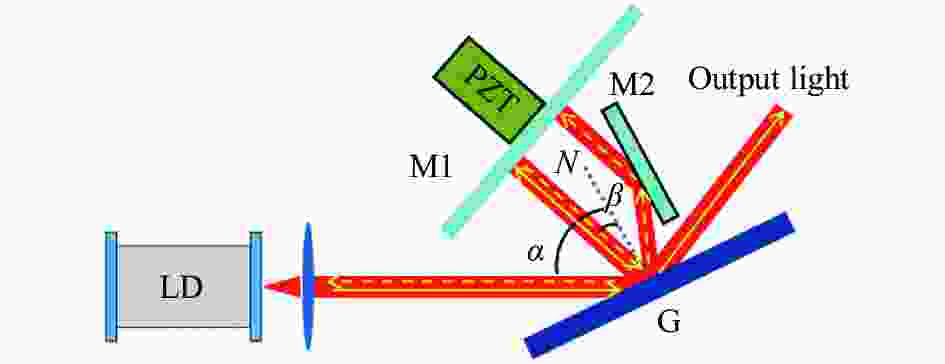-
外腔可调谐半导体激光器具有输出线宽窄、光谱特性优越、效率高以及波长可调谐等优点[1],广泛应用于光纤波分复用、干涉测量、激光雷达以及相干光通信系统等领域[2-5]。
根据波长调谐方式不同,可将以闪耀光栅作为反馈元件的外腔半导体激光器(External Cavity Diode Lasers, ECDL)分为Littrow和Littman-Metcalf两种结构[6-7]。相比而言,Littman-Metcalf结构由于闪耀光栅的两次衍射以及色散作用,可获得更高的SMSR以及更窄的线宽[8-9]。通过微调外腔反射镜的角度,改变半导体激光器(LD)的谐振波长,调谐过程中激光器输出光方向固定,不需要额外的光束补偿器。但是光束在Littman-Metcalf结构激光器外腔会发生两次衍射,使得外腔衍射损耗增大,输出功率也较低[10]。
对于光栅外腔半导体激光器而言,如何在获得超窄线宽输出的同时降低外腔损耗、增大输出功率是设计中应重点考虑的问题。陈怡详细计算了激光器外腔参数对增益系数以及输出功率的影响,计算结果表明:输出功率会随着外腔腔长以及闪耀光栅衍射效率的增大而减小,提高光栅与激光器的耦合效率会增大外腔激光器的输出功率[11]。刘野等人采用全息光栅作为反馈元件,极大的改善了半导体激光器的性能,并指出:在LD的输出端镀减反膜能够进一步降低外腔半导体激光器的阈值电流,从而获得更高的输出功率[12]。高志强等人通过分析外腔激光器不同波长下的P-I特性,发现选用较大数值孔径的非球面准直镜和高衍射效率闪耀光栅能够有效降低内腔的有害损耗,从而提高外腔半导体激光器的输出功率[13]。刘荣战等人采用反射率为20%的反射型布拉格光栅作为外腔反馈元件构成了红光外腔半导体激光器,降低了闪耀光栅多级次衍射造成的光强损耗,可将半导体激光器的输出波长稳定锁定在634 nm附近,输出功率高达1.06 W[14]。Stephen R.Wells等人以传统外腔半导体激光器结构为基础,将外腔半导体激光器与锥形放大器(TPAS)耦合,降低了光强损耗,可实现240 mW稳定输出功率[15]。以上研究主要以激光器外腔参数,如腔长、端面反射率等为重点来分析如何降低损耗、提高功率。作为整个结构中的关键器件,闪耀光栅的二次衍射难以避免,也会带来损耗,如何处理这一问题还没有详细的分析研究。
文中在传统的Littman-Metcalf外腔结构中,增加了一个反射镜,将闪耀光栅第二次衍射产生的零级衍射光反馈回半导体激光器有源腔,降低因闪耀光栅引起的外腔损耗。仿真分析了新模型与传统Littman-Metcalf模型外腔反馈对半导体激光器的外腔损耗、阈值特性、输出线宽以及输出功率的影响。同时,对影响所提出外腔半导体激光器输出线宽以及输出功率的因素进行了系统的分析。
-
低损耗Littman-Metcalf型光栅外腔半导体激光器结构如图1所示,在传统Littman-Metcalf结构的闪耀光栅G和反射镜M1之间新增一块反射镜M2,该反射镜垂直于光栅面放置。由半导体激光器出射的激光光束以
$ \alpha $ 角度入射闪耀光栅发生第一次衍射(如图1实线箭头所示),其衍射效应遵循光栅方程:式中:
$ d $ 为光栅常数;$ \lambda $ 为光波长;$ \alpha $ 为入射角;$\; \beta $ 为衍射角;$ m $ 为衍射级次。其中零级衍射光离开外腔直接输出,当$ m = 1 $ 时,满足$ {\lambda _1} = d\left( {\sin \alpha + \sin \gamma } \right) $ ($ \gamma $ 为一级衍射角)的一级衍射光则垂直入射调谐反射镜M1。经调谐反射镜M1反射的衍射光束会再次入射闪耀光栅,发生第二次衍射(如图1虚线箭头所示),此时大部分光束将以
$ \gamma $ 为入射角发生一级衍射返回LD本征腔。由于闪耀光栅无法实现理想的100%一级衍射效率,因此还有少量零级衍射光,其衍射角为$ - \gamma $ 。传统的Littman-Metcalf结构将此光束舍弃掉,为了进一步提高外腔的耦合效率,在闪耀光栅与反射镜M1之间再设置一个反射镜M2,使光束以$ \pi /2 - \gamma $ 角度入射M2,再次入射调谐反射镜M1并原路返回至半导体激光器有源腔,产生振荡。 -
如图2所示[16],在没有外腔反馈注入时,LD的两个解理面之间构成了F-P腔体,
$ {R_1} $ 、$ {R_2} $ 分别为激光器前后端面反射率。当有外腔反馈注入LD时,设$ l $ 、L分别为内腔和外腔长度,外腔反馈光的影响用一个反射系数为${R_{{\rm{out}}}}$ 的反射镜等效。这样一来,外腔反射损耗、衍射损耗等因素可以反映在系数${R_{{\rm{out}}}}$ 中。
Figure 2. (a) Schematic diagram of semiconductor laser with external cavity feedback; (b) Equivalent resonator after introducing equivalent reflection coefficient
引入等效反射系数的概念,可以将
$ {R_2} - {R_{{\rm{out}}}} $ 平面等效为一个反射系数为$ {R_{{\rm{eff}}}} $ 的平面,如图2(b)所示,此时的等效反射率为:当外腔模型为Littman-Metcalf结构时,根据光路可得此时的外腔反射率为:
式中:
$ {R_d} $ 为闪耀光栅的一级衍射效率;$ {R_3} $ 为调谐反射镜的反射效率。当外腔模型为低损耗Littman-Metcalf结构时,根据光路可得此时的外腔反射率为:
式中:
$ {R_4} $ 为新增反射镜反射率。光波在激光器内传播时,产生损耗的主要因素包括:自由载流子对光的吸收损耗
$ {\alpha _{fc}} $ ,衍射损耗${\alpha _{{\rm{dif}}}}$ 和端面输出引入的损耗[17],所以在有源区光波的损耗系数为:由此可得Littman-Metcalf模型端面输出引入的损耗为:
低损耗Littman-Metcalf模型端面输出引入的损耗为:
结合Littman-Metcalf模型阈值电流计算公式[18],改进后光栅外腔半导体激光器的阈值电流为:
式中:
$ {I_0} $ 为未加外腔反馈时半导体激光器的阈值电流;$ {\tau _p} $ 为光子寿命;$ {w_0} $ 为振荡频率。外腔半导体激光器输出线宽为[19]:
式中:
$ \tau $ 为与谐振腔长度有关的光子寿命;$ \tau = 2 nl/c $ 。由公式(9)可以看出,外腔半导体激光器的输出线宽与谐振腔腔长、端面反射率以及外腔光强反馈效率有关,在外腔增加反射镜后等效于增大了激光器谐振器腔长,这样有利于进一步压窄输出线宽。在稳态条件下,增加外腔反馈的半导体激光器的输出功率为[19]:
式中:
$ \nu $ 是半导体激光器的器件参数,表示为:式中:
${\varGamma }$ 为制约因子;$ \varepsilon $ 为注入电流转换效率;$ h $ 为普朗克常量;$ {\tau _M} $ 为光子寿命;$ q $ 为电荷常量。$ \varOmega $ 和$ {G_{th}} $ 分别为振荡频率和阈值增益,表示为:由上式可得,外腔半导体激光器的输出功率不仅与半导体激光器有源腔参数有关,还受外腔腔长、闪耀光栅衍射效率以及外腔反馈反射镜反射率的影响。
-
首先针对了闪耀光栅一级衍射效率不同时,传统Littman-Metcalf腔结构和改进外腔结构的外腔损耗进行了计算,计算中使用的主要参数如下:吸收损耗
$ {\alpha _{fc}} $ 和衍射损耗${\alpha _{{\rm{dif}}}}$ 取30 cm−1,半导体激光器端面反射率分别为90%、10%,内腔长l设为200 μm,外腔两块反射镜反射率均为99%。利用公式(6)、(7)得到如图3所示计算结果。
Figure 3. Effect of first order diffraction efficiency of blazed gratings on the loss of external cavity semiconductor lasers
由图3可见,随着闪耀光栅一级衍射效率的增加,外腔引入的损耗呈下降趋势。在相同的衍射效率下,相比传统模型,文中低损耗Littman-Metcalf模型所造成的的外腔损耗更低。衍射效率为0.6时,传统模型的损耗为52.75 cm−1,文中模型为46.16 cm−1,损耗降低12.49%。
由于外腔损耗降低,改进后的半导体激光器阈值电流也随之下降,分析了两种外腔半导体激光器的阈值电流,主要计算参数为:
$ {I_0} $ =50 mA,$ {f_d} $ =125 GHz,外腔反射镜反射率均为99%,振荡频率$ {w_0} = 2\pi c/\lambda $ ,波长$ \lambda $ 为635 nm,折射率$ n $ 设为1。改进前后两种结构在闪耀光栅衍射效率不同时,对应的阈值电流如图4所示。
Figure 4. Effect of the first order diffraction efficiency of a blazed grating on threshold current of an external cavity semiconductor laser
随着闪耀光栅一级衍射效率的增大,半导体激光器的阈值电流降低的越明显。与传统模型相比,文中提出的低损耗Littman-Metcalf模型能够进一步降低半导体激光器的阈值电流,在闪耀光栅一级衍射效率为0.6时,传统模型的阈值电流为43.3 mA,改进后激光器的阈值电流为40.03 mA,降低了约7%。
输出线宽也是外腔半导体激光器非常重要的一个参数,设半导体激光器的本征线宽
$ \Delta {v_0} $ 为100 MHz,激光器内腔长度$ l $ 为0.3 mm,外腔长度$ L $ 为30 mm,端面反射率$ {R_2} $ 取0.4%,外腔反射镜反射率均为99%。将公式(3)、(4)分别代入公式(9)可得闪耀光栅一级衍射效率对两种结构外腔激光器的输出线宽影响规律,如图5所示。
Figure 5. Effect of the first order diffraction efficiency of a blazed grating on threshold current of an external cavity semiconductor laser
从计算结果可以发现,低损耗Littman-Metcalf相比传统结构进一步提高了对半导体激光器输出线宽的压窄作用,外腔损耗的降低,使得反馈增强,在闪耀光栅一级衍射效率为0.3时,传统模型的输出线宽为10.2 kHz,而低损耗Littman-Metcalf模型的输出线宽为5.55 KHz。随着闪耀光栅一级衍射效率的增大,外腔反馈对半导体激光器的输出线宽压窄作用更明显。随着衍射效率的增大,两种模型对半导体激光器的线宽压窄作用趋于一致。
当注入电流为200 mA时,将公式(3)、(4)分别代入公式(10)~(13),可得Littman-Metcalf模型和文中模型外腔激光器输出功率,如图6所示。

Figure 6. Effects of the first order diffraction efficiency of the blazed grating on the output power of the external cavity semiconductor laser
由计算结果可得,随着闪耀光栅衍射效率的增加,两种结构外腔激光器的输出功率都呈现增强的趋势,且无论闪耀光栅一级衍射效率为何值时,低损耗Littman-Metcalf模型的输出功率都要比传统模型的输出功率要高,衍射效率越高,差距越明显。在衍射效率为0.4时,传统模型输出功率为0.1109 mW,文中模型为0.3673 mW,衍射效率为0.9时,传统模型输出功率为0.7028 mW,文中模型为2.7183 mW。由此可知,低损耗Littman-Metcalf模型很大程度上增强了激光器的输出。
-
除了闪耀光栅的衍射效率外,外腔参数对激光器输出线宽、输出功率也会产生影响。
首先使用公式(9)对影响低损耗Littman-Metcalf外腔激光器输出线宽的因素进行分析,计算中所用主要参数为:内腔长
$ l $ 为200 μm,外腔长$ L $ 为45 mm,出射端面反射率$ {R}_{2} $ 为1%,闪耀光栅一级衍射效率$ {R}_{d} $ 为65%,两块反射镜反射率均为99%。计算结果如图7所示,由此可知外腔反馈的引入能够将本征线宽为100 MHz的半导体激光器出射激光压窄至kHz量级。图7(a)和(b)分别计算了半导体激光器有源腔腔长以及输出端面反射率对输出线宽的影响,随着有源腔腔长以及端面反射率的增大,外腔激光器的线宽压窄作用减弱。图7(c)计算了外腔腔长对输出线宽的影响,由此可知增大外腔腔长有利于实现超窄线宽输出,然而当外腔腔长大于80 mm时,线宽压窄作用不再明显,考虑到增大腔长会增加外腔损耗、降低输出功率以及激光器结构的紧凑性等,因此实现理想的输出应该合理的选择外腔长度。图7(d)和(e)分别计算了外腔两块反射镜反射率对输出线宽的影响,结果显示高反射率反射镜有利于进一步压窄线宽,因此在实际设计中应尽可能选择反射率接近100%的反射镜。
Figure 7. Effect of (a) the end-face reflectance of the semiconductor laser, (b) the length of internal cavity, (c) the length of external cavity, (d) the reflectance of M1, (e) the reflectance of M2 on the output linewidth of the low loss Littman-Metcalf external cavity semiconductor laser
使用公式(10)~(13)对影响低损耗Littman-Metcalf外腔激光器输出功率的因素进行仿真分析,计算中主要参数如下:波长
$ \lambda $ 为655 nm,半导体激光器前后端面反射率分别为99%、0.1%,光栅一级衍射效率$ {R}_{d} $ 为65%,两块反射镜反射率均为99%。内腔长$ l $ 为200 μm,外腔长$ L $ 为40 mm。计算结果如图8所示。图8(a)和(b)分别计算了半导体激光器前后端面反射率对外腔激光器输出功率的影响,由图可见输出功率随着端面反射率的增大而增大,且后端面反射率变化对功率的影响更为剧烈。图8(c)计算了外腔腔长对激光器输出功率的影响,由计算结果可得,随着外腔腔长的增大,激光器输出功率降低,在外腔长度小于40 mm时,输出功率对腔长变化比较敏感,当腔长大于40 mm时,外腔长度变化对激光器输出功率的影响较小。综合图7(c)考虑,在实际设计中外腔腔长应在20~40 mm之间,这样既能实现超窄线宽输出也能具备较大的输出功率,同时也提高了系统的紧凑型。图8(d)和(e)分别计算了外腔两块反射镜反射率对输出功率的影响,反射率的增大降低了光束的反射损耗,综合图7(d)和(e)考虑,实际设计中应该尽可能选择反射率高的反射镜。
Figure 8. Effect of (a) the front-face reflectance of semiconductor laser, (b) the end-face reflectance of the semiconductor laser, (c) the length of external cavity, (d) the reflectance of M1, (e) the reflectance of M2 on the output power of the low-loss Littman-Metcalf external cavity semiconductor laser
-
文中提出一种新的外腔结构模型,在传统Littman-Metcalf结构外腔激光器的基础上增加了一块反射镜,将二次衍射产生的零级光反馈回本征腔。从外腔损耗、阈值电流、输出线宽、输出功率四个角度对新结构模型进行了仿真分析,计算结果证明了该结构能够降低外腔损耗,衍射效率为0.6时,能够将传统Littman-Metcalf模型的外腔损耗降低12.49%,阈值电流降低了7%,激光器的输出功率也随之提高。由于外腔耦合效率的增加,低损耗Littman-Metcalf模型的线宽压窄作用更加明显,在衍射效率为0.3时,低损Littman-Metcalf模型输出线宽约为传统模型的50%。同时对影响外腔激光器输出线宽、输出功率的因素进行了系统的分析。结果表明,当外腔长度大于40 mm时,长度变化对激光器输出功率影响较小,而当长度大于80 mm时,外腔对激光器线宽压窄的作用不再明显。综合考虑激光器的线宽压窄能力、输出功率以及紧凑程度,应该将外腔长度控制在20~40 mm。随着半导体激光器输出端面反射率的增大,激光器输出线宽随之增大,实际应用中应该选择镀有增透膜的半导体激光器,使外腔光束更多的进入半导体激光器本征腔。外腔反射镜反射率增大有利于压窄输出线宽、提高输出功率,因此实际应用中应该尽可能选择高反射率反射镜。该计算结果对后期激光器制作具有一定的指导意义。
Optimal design for reducing diffraction loss of Littman-Metcalf grating external cavity semiconductor laser
doi: 10.3788/IRLA20220206
- Received Date: 2022-03-21
- Rev Recd Date: 2022-04-15
- Accepted Date: 2022-04-20
- Publish Date: 2023-01-18
-
Key words:
- external cavity feedback /
- external cavity loss /
- threshold current /
- external cavity diode lasers /
- line width
Abstract: Based on the working principle of Littman-Metcalf type grating external cavity semiconductor laser, an external cavity structure which can reduce diffraction loss is designed. Based on the Littman-Metcalf structure, a reflector is added to feed back the zero-order diffraction light generated by the secondary diffraction of the shining grating to the intrinsic cavity of the semiconductor laser. The expression of the external cavity loss of the new structure model is derived, and the external cavity loss, threshold current, output line width and output power of the two laser structures are simulated by the concept of equivalent cavity. The results show that the zero-order light fed back to the active region can effectively reduce the external cavity loss of the Littman-Metcalf structure laser and improve the coupling efficiency of the system, thus reducing the threshold current and improving the output power of the laser. At the same time, the output linewidth of the laser is further narrowed by improving the reflection efficiency of the external cavity. The factors affecting the output linewidth and output power of low loss Littman-Metcalf external cavity laser (end reflectivity, internal and external cavity length, blazed grating diffraction efficiency and mirror reflectivity) are also simulated and analyzed. It improves the theoretical guidance for the later laser production.



































































 DownLoad:
DownLoad:






